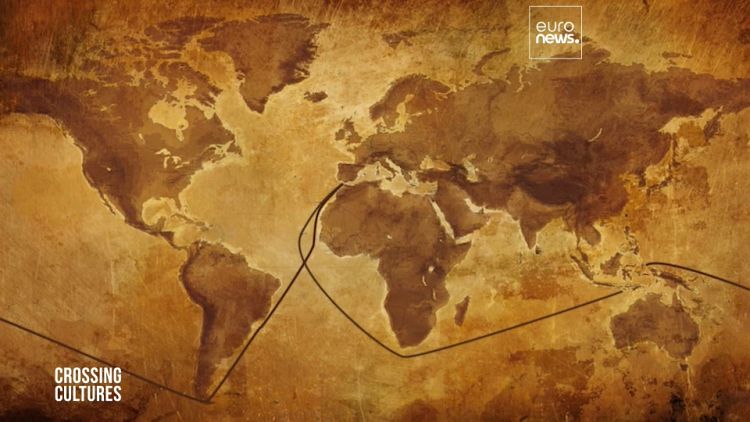You are here
Crossing Cultures: How China and Europe mastered the sea
Crossing Cultures: How China and Europe mastered the sea
Paul Hackett 22/10/2023 https://www.euronews.com/culture/2023/10/22/crossing-cultures-how-china-...
In the world of maritime history, the connection between China and Europe is a tale woven through centuries of exploration, trade, and innovation. In this episode of Crossing Cultures, we embark on a journey to uncover the rich maritime heritage that binds these two distant regions together.
For millennia, China has embraced the sea as a vital conduit for trade and cultural exchange.
The Maritime Silk Road, a network of maritime routes, was the lifeblood of this connectivity, enabling the transport of valuable goods, such as tea and silk, to far-flung corners of the globe.
Navigating treacherous waters was a perilous endeavor, especially for vessels laden with heavy cargo. Chinese shipbuilders devised a revolutionary solution: the Fu Ship. These vessels introduced watertight-bulkhead technology, enhancing their resilience against storms and rough seas.
"In ancient times, on the Fujian coast, our ancestors lived on the sea and by the sea,” says Zhang Guohui, a Fu ship model maker. “Ships were basically the source of their livelihood, so they were constantly evolving, from the earliest rafts and canoes to Fu Ships, designed for long voyages.”
Archaeological evidence reveals that as early as the Song Dynasty (10th to 13th centuries), merchant ships employed bulkheads, a practice still employed in modern shipbuilding. These partitions not only prevented complete flooding in case of an accident but also facilitated cargo storage and stability.
Guohui, explains that the name "Fu Ship" partly derives from "Fujian," the region where these ships were made, and the auspicious meaning of the Chinese character "Fu," signifying "good luck".
The Fu Ship's resurgence
While modern steel-hulled vessels replaced the traditional Fu Ships, Lin Peizong and his team in 2020 undertook the remarkable task of constructing a full-scale replica of a Ming Dynasty-era Fu Ship. This endeavour rekindled the spirit of ancient maritime exploration.
"I've been a sailor for nine years. I inherited the technique of creating watertight compartments. For those of us who live on the sea, the Fu Ships are our home. My dream is to sail the Maritime Silk Road with a Fu Ship," Peizong says.
Nao Victoria: Europe's odyssey around the world
If the Fu Ship took China to the world, the Nao Victoria quite literally went around it.
In 1519, Portuguese explorer Ferdinand Magellan embarked on arguably the greatest sea voyage ever undertaken. Setting sail from Seville in a five-ship flotilla, his mission on behalf of the Spanish crown was to find a western route to the Moluccas, or Spice Islands, in modern-day Indonesia.
Forging across the vast Pacific Ocean, starvation and scurvy set in. The expedition didn’t make landfall for almost 100 days. What lay ahead was a gruelling 3-year journey marked by mutiny, murder, and ultimately his death. It was a perilous journey across the Pacific.
The crew faced daunting challenges, including starvation and scurvy, during their 100-day voyage across the Pacific Ocean. Life on board the Nao Victoria was grim, with limited access to fresh water and fruits. A lot of them did not survive.
"They underestimated the size of the Pacific Ocean, so they were not sufficiently equipped for the crossing," explains Javier Juan Polo Polo, First Mate on the Nao Victoria. "Also, some of them were trapped, captured, or killed by natives or the Portuguese.”
The Triumph of Juan Sebastián Elcano
Upon reaching the Philippines, Magellan was killed in a battle with local tribes. The expedition then fell into the hands of Juan Sebastián Elcano, who led and pressed on with the voyage. Elcano managed to complete the circumnavigation by sailing the Nao Victoria alone across the Indian Ocean and around Africa's Cape of Good Hope, returning to Spain with a cargo of spices.
“It's funny because he was not even a captain at the beginning of the expedition and he took part in a mutiny against Magellan. He got promoted later on as a result of the crew decreasing." Javier explains.
Of the 250 men who embarked on the voyage, only 18 returned on the Nao Victoria, but they had achieved a monumental feat. Their journey introduced the Western world to the Pacific Ocean, new spices, and new vital trade routes, while also revealing the true size of the Earth.

